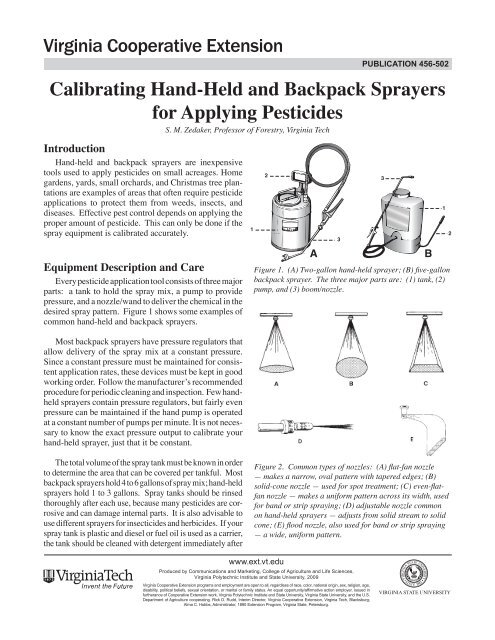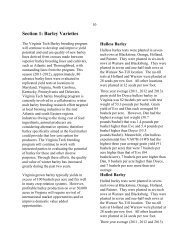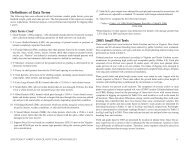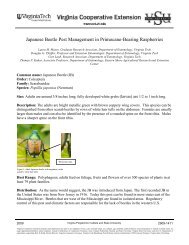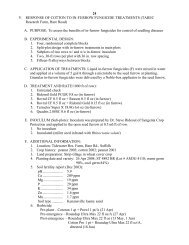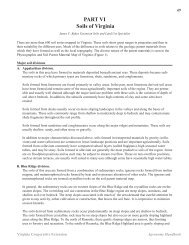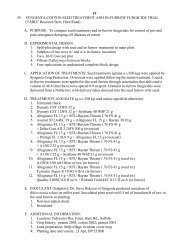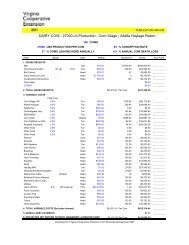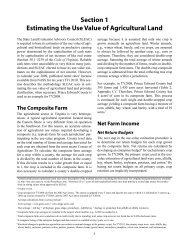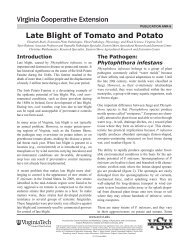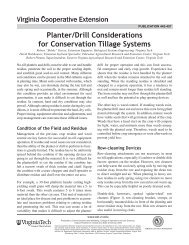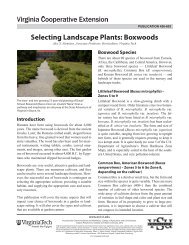Calibrating Hand-Held and Backpack Sprayers for Applying Pesticides
Calibrating Hand-Held and Backpack Sprayers for Applying Pesticides
Calibrating Hand-Held and Backpack Sprayers for Applying Pesticides
Create successful ePaper yourself
Turn your PDF publications into a flip-book with our unique Google optimized e-Paper software.
publication 456-502<br />
<strong>Calibrating</strong> <strong>H<strong>and</strong></strong>-<strong>Held</strong> <strong>and</strong> <strong>Backpack</strong> <strong>Sprayers</strong><br />
<strong>for</strong> <strong>Applying</strong> <strong>Pesticides</strong><br />
S. M. Zedaker, Professor of Forestry, Virginia Tech<br />
Introduction<br />
<strong>H<strong>and</strong></strong>-held <strong>and</strong> backpack sprayers are inexpensive<br />
tools used to apply pesticides on small acreages. Home<br />
gardens, yards, small orchards, <strong>and</strong> Christmas tree plantations<br />
are examples of areas that often require pesticide<br />
applications to protect them from weeds, insects, <strong>and</strong><br />
diseases. Effective pest control depends on applying the<br />
proper amount of pesticide. This can only be done if the<br />
spray equipment is calibrated accurately.<br />
Equipment Description <strong>and</strong> Care<br />
Every pesticide application tool consists of three major<br />
parts: a tank to hold the spray mix, a pump to provide<br />
pressure, <strong>and</strong> a nozzle/w<strong>and</strong> to deliver the chemical in the<br />
desired spray pattern. Figure 1 shows some examples of<br />
common h<strong>and</strong>-held <strong>and</strong> backpack sprayers.<br />
1<br />
2<br />
A<br />
3<br />
Figure 1. (A) Two-gallon h<strong>and</strong>-held sprayer; (B) five-gallon<br />
backpack sprayer. The three major parts are: (1) tank, (2)<br />
pump, <strong>and</strong> (3) boom/nozzle.<br />
3<br />
B<br />
1<br />
2<br />
Most backpack sprayers have pressure regulators that<br />
allow delivery of the spray mix at a constant pressure.<br />
Since a constant pressure must be maintained <strong>for</strong> consistent<br />
application rates, these devices must be kept in good<br />
working order. Follow the manufacturer’s recommended<br />
procedure <strong>for</strong> periodic cleaning <strong>and</strong> inspection. Few h<strong>and</strong>held<br />
sprayers contain pressure regulators, but fairly even<br />
pressure can be maintained if the h<strong>and</strong> pump is operated<br />
at a constant number of pumps per minute. It is not necessary<br />
to know the exact pressure output to calibrate your<br />
h<strong>and</strong>-held sprayer, just that it be constant.<br />
The total volume of the spray tank must be known in order<br />
to determine the area that can be covered per tankful. Most<br />
backpack sprayers hold 4 to 6 gallons of spray mix; h<strong>and</strong>-held<br />
sprayers hold 1 to 3 gallons. Spray tanks should be rinsed<br />
thoroughly after each use, because many pesticides are corrosive<br />
<strong>and</strong> can damage internal parts. It is also advisable to<br />
use different sprayers <strong>for</strong> insecticides <strong>and</strong> herbicides. If your<br />
spray tank is plastic <strong>and</strong> diesel or fuel oil is used as a carrier,<br />
the tank should be cleaned with detergent immediately after<br />
Figure 2. Common types of nozzles: (A) flat-fan nozzle<br />
— makes a narrow, oval pattern with tapered edges; (B)<br />
solid-cone nozzle — used <strong>for</strong> spot treatment; (C) even-flatfan<br />
nozzle — makes a uni<strong>for</strong>m pattern across its width, used<br />
<strong>for</strong> b<strong>and</strong> or strip spraying; (D) adjustable nozzle common<br />
on h<strong>and</strong>-held sprayers — adjusts from solid stream to solid<br />
cone; (E) flood nozzle, also used <strong>for</strong> b<strong>and</strong> or strip spraying<br />
— a wide, uni<strong>for</strong>m pattern.<br />
www.ext.vt.edu<br />
Produced by Communications <strong>and</strong> Marketing, College of Agriculture <strong>and</strong> Life Sciences,<br />
Virginia Polytechnic Institute <strong>and</strong> State University, 2009<br />
Virginia Cooperative Extension programs <strong>and</strong> employment are open to all, regardless of race, color, national origin, sex, religion, age,<br />
disability, political beliefs, sexual orientation, or marital or family status. An equal opportunity/affirmative action employer. Issued in<br />
furtherance of Cooperative Extension work, Virginia Polytechnic Institute <strong>and</strong> State University, Virginia State University, <strong>and</strong> the U.S.<br />
Department of Agriculture cooperating. Rick D. Rudd, Interim Director, Virginia Cooperative Extension, Virginia Tech, Blacksburg;<br />
Alma C. Hobbs, Administrator, 1890 Extension Program, Virginia State, Petersburg.
use. The oil may impregnate the plastic, leaving pesticide<br />
residue that could affect future applications.<br />
<strong>H<strong>and</strong></strong>-held <strong>and</strong> backpack sprayers usually come equipped<br />
with a trigger valve <strong>and</strong> spray w<strong>and</strong> to which a single nozzle<br />
is attached. Nozzles come in various shapes <strong>and</strong> sizes <strong>and</strong><br />
are carried by most agricultural chemical dealers (Figure<br />
2). The newer nylon nozzles are lighter, more resistant to<br />
abrasive damage, <strong>and</strong> will not corrode. For spot applications,<br />
hollow or solid-cone nozzles work well, but only even-flatfan<br />
or flood-jet types should be used <strong>for</strong> single-nozzle b<strong>and</strong><br />
applications. These nozzles will deliver a relatively even<br />
pattern <strong>and</strong> a constant application rate across the b<strong>and</strong>. Nozzle<br />
output is measured in gallons per minute (GPM) at different<br />
pressures. Nozzles with low delivery rates (less volume per<br />
minute) are best <strong>for</strong> small sprayers, since more acreage can<br />
be covered with less carrier (water, oil, etc.). The angle of a<br />
nozzle’s spray pattern <strong>and</strong> the height at which it is held from<br />
the ground determine the width of the spray pattern (Figure<br />
3). This width is known as the effective swath width (ESW)<br />
<strong>and</strong> is important <strong>for</strong> sprayer calibration.<br />
Sprayer Calibration<br />
Two methods of calibration will be described. These are (1) spray delivery rate <strong>and</strong> (2) known area rate. Although<br />
either can be used alone, both should be completed as a check <strong>for</strong> accuracy. Method 1 is the idealized calibration,<br />
while Method 2 is the operational check. Adjustments in the rate of travel, nozzle height, or pressure/pump rate can<br />
be made if calibrations by the two methods do not match. Calibrations should be done with only water in the tank<br />
<strong>and</strong> in calm air, with wind not exceeding 7 miles per hour.<br />
Method 1 — Spray Delivery Rate<br />
1. Lay out a 100-foot-long course in your plantation, yard, field, driveway, or road.<br />
2. Fill your sprayer half full, <strong>and</strong> pump it to the normal operating pressure to simulate the average spray situation.<br />
3. Traverse the course four times, spraying in a straight line as you would in a b<strong>and</strong> application. Record time of<br />
each traverse to the nearest second, <strong>and</strong> measure the effective swath width (ESW) — width of wetted ground,<br />
foliage, or pavement — at several points along each traverse. Hold the nozzle at a consistent height above the<br />
ground. The height will vary <strong>for</strong> different people, but it should be one that is com<strong>for</strong>table, normally between<br />
18 <strong>and</strong> 24 inches above the ground.<br />
4. Next, fill a gallon container four times from the sprayer, using the pump rate or pressure setting <strong>and</strong> nozzle<br />
used in the traverse in step #3 above. Time each fill to the nearest second. Determine the average gallons/<br />
minute using:<br />
60 seconds/minute = gallons/minute<br />
average seconds/gallon<br />
Figure 3. (A) <strong>and</strong> (B) show how the angle of the spray<br />
pattern affects the width of the pattern. As the angle, x, is<br />
increased from (A) to 2x in (B), the pattern width increases<br />
proportionately. The height of the nozzle above the ground<br />
also affects the width of the spray pattern, as shown in (C)<br />
<strong>and</strong> (D). As the height, y, in (C) increases to a height of z in<br />
(D), the pattern width increases proportionately.<br />
For example, if the times <strong>for</strong> filling the gallon container are 350 seconds, 338 seconds, 335 seconds, <strong>and</strong> 340<br />
seconds, the average time is 340.8 seconds/gallon. Using the <strong>for</strong>mula, gallons/minute are then calculated:<br />
60 seconds/minute = 0.176 gallons/minute<br />
340.8 seconds/gallon<br />
2
5. Determine the area covered per minute by the following <strong>for</strong>mula (assuming a 100-foot traverse):<br />
ESW in inches X 1 = acres/minute<br />
average time in seconds <strong>for</strong> traverse 87.12<br />
For example, if the sprayer’s ESW is 24 inches, <strong>and</strong> the four 100-foot traverses are timed at 23, 25, 23, <strong>and</strong><br />
24 seconds, the average time is 23.75 seconds. Using the above <strong>for</strong>mula, acres covered per minute are calculated:<br />
24 X 1 = 24 = 0.0116 acres/minute<br />
23.75 87.12 2069.1<br />
6. Determine gallons/acre using:<br />
gallons/minute = gallons/acre<br />
acres/minute<br />
This is the carrier rate your sprayer delivers using the pressure setting/pump rate, nozzle, nozzle height, <strong>and</strong><br />
walking speed you have.<br />
Thus, using the data calculated in examples #4 <strong>and</strong> #5 <strong>and</strong> the <strong>for</strong>mula above, the number of gallons required<br />
per acre can be determined:<br />
0.176 gallons/minute = 15.17 gallons/acre<br />
0.0116 acres/minute<br />
7. Determine the area that can be sprayed by your sprayer <strong>for</strong> each tankful using:<br />
gallons/tank = acres/tank<br />
gallons/acre<br />
Finally, using the above calculations, the area that can be sprayed with each tankful of a 5-gallon sprayer is:<br />
5 gallons/tank = 0.33 acres/tank<br />
15.17 gallons/acre<br />
Method 2:<br />
1. Fill your sprayer to a known mark between 1/2 <strong>and</strong> 3/4 full.<br />
2. Lay out a 66-foot by 66-foot square plot (1/10 acre) in your plantation, yard, field, or other level area.<br />
3. Spray the plot at the pace <strong>and</strong> nozzle height used in Method 1. Be sure to cover the plot completely, but do<br />
not overlap spray swaths.<br />
4. Refill the sprayer to the known mark, measuring the amount of water needed to the nearest cup (8 fluid<br />
ounces).<br />
5. Calculate the gallons/acre using the following:<br />
no. of cups<br />
16 cups/gallon<br />
X 10 = gallons/acre<br />
For example, if you measure 24.5 cups in step #4 above, the gallons/acre will be:<br />
24.5 no. of cups X 10 = 15.31 gallons/acre<br />
16 cups/gallon<br />
3
6. Calculate the area that can be covered by your sprayer per tankful using Method 1, #7. Recall that the <strong>for</strong>mula<br />
used in Method 1, #7, was:<br />
gallons/tank = acres/tank<br />
gallons/acre<br />
There<strong>for</strong>e, using the same 5-gallon sprayer <strong>and</strong> the gallons/acre calculated in #5 above:<br />
5 gallons/tank = 0.327 acres/tank<br />
15.31 gallons/acre<br />
For accurate chemical application, gallons/acre calculations <strong>for</strong> Methods 1 <strong>and</strong> 2 should agree within 10 percent.<br />
To check this, use:<br />
gallons/acre Method 1 - gallons/acre Method 2 X 100 = +/-% error<br />
gallons/acre Method 1<br />
For example, in Method 1, 0.330 acres were covered per tank, <strong>and</strong> in Method 2, 0.327 acres were covered<br />
per tank. Using the above <strong>for</strong>mula, determine the percentage of error:<br />
(0.330 - 0.327) X 100 = 0.009 X 100 = 0.9% error<br />
0.330<br />
An error of 0.9 percent is within the desired accuracy range of +10 percent.<br />
If your actual calibrations result in an error exceeding 10 percent, recheck your calculations. If still in error,<br />
repeat Method 2, adjusting your pace, nozzle height, or pump rate to more closely approximate those used in<br />
Method 1. Be more careful to completely cover the 1/10 acre, but do not overlap spray swaths. Accuracy will<br />
improve with practice, but you should always strive to be within the +10 percent allowable error.<br />
Spray Mixture<br />
Once your sprayer is calibrated, you must determine the amount of pesticide needed per tank <strong>and</strong> <strong>for</strong> your entire<br />
operation. If pesticide recommendations are given in amount (pounds or gallons) of product/acre to apply, simply<br />
multiply amount/acre by acres/tank to determine amount/tank of pesticide needed.<br />
For example, if 4 pounds of product are recommended per acre <strong>and</strong> the sprayer used can cover 0.2 acres per<br />
tank, the amount needed per tank is:<br />
4 pounds X 0.2 acres = 0.8 pounds/tank<br />
1 acre tank<br />
Often, pesticide rates are given in amount of active ingredient per acre (a.i./acre). Since pesticides are never <strong>for</strong>mulated<br />
as pure active ingredient, it is necessary to compute the amount of product/acre needed to apply the desired<br />
amount of a.i./acre. To calculate this <strong>for</strong> dry-<strong>for</strong>mulated chemicals, divide the a.i./acre by the percentage of active<br />
ingredient listed on the label expressed by a decimal.<br />
For example, if the active ingredient is listed as 75 percent of the <strong>for</strong>mulated product, <strong>and</strong> 3 pounds of active<br />
ingredient per acre are recommended, then 3 pounds a.i./acre divided by 0.75 a.i./pound equals 4 pounds of product<br />
needed per acre (3 ÷ 0.75 = 4).<br />
Liquid <strong>for</strong>mulations often state the pounds a.i./gallon. If the application rate is given in pounds a.i./acre, divide<br />
pounds a.i./acre by pounds a.i./gallon to give gallons/acre of product necessary.<br />
4
For example, if the product label lists the <strong>for</strong>mulation as 4 pounds a.i./gallon <strong>and</strong> the recommendation calls <strong>for</strong><br />
3 pounds a.i./acre, then:<br />
3 pounds a.i. /acre = 0.75 gallons/acre of product required<br />
4 pounds a.i. /gallon<br />
Regardless of the <strong>for</strong>mulations, once the amount of product/acre is calculated, again simply multiply the amount/<br />
acre by acres/tank from your calibration to determine amount of pesticide to be added <strong>for</strong> each tankful of spray mix.<br />
Thus, if 0.75 gallons of product are needed per acre <strong>and</strong> 0.2 acres can be sprayed per tank, then 0.75 gallons/acre x<br />
0.2 acre/tank = 0.15 gallons/tank.<br />
To determine pesticide needs <strong>for</strong> your entire operation, multiply acres to be sprayed by amount of product/acre. To<br />
determine tankfuls to be mixed, divide acres to be sprayed by acres/tank. Remember, only the area actually sprayed<br />
should be used. If b<strong>and</strong> or spot applications are used, this is only a fraction of the total plantation area.<br />
Example<br />
Chris Tree wanted to spray atrazine, as Aatrex 80W (the “W” indicates the herbicide is in a wettable powder <strong>for</strong>m),<br />
in his 20-acre white pine Christmas tree plantation. Mr. Tree marked out a 100-foot traverse in his plantation. He<br />
filled his 4-gallon backpack sprayer half full with water, installed a 15-psi (pounds per square inch) pressure spring<br />
in the regulator, <strong>and</strong> attached an even‐ flat-fan nozzle. Holding the nozzle at a constant height, he then sprayed the<br />
traverse four times, timing each traverse <strong>and</strong> measuring the ESW at several points. His travel times were 21, 24, 23,<br />
<strong>and</strong> 24 seconds. His average travel time was 23 seconds. His average ESW was 36 inches. He then filled a 1-gallon<br />
milk jug four times. His average fill time was 182 seconds (3 minutes, 2 seconds). His delivery rate was:<br />
60 seconds/minute = 0.33 gallons/minute<br />
23 seconds<br />
His area covered per minute was:<br />
36 inches X 1 = 0.01799 acres/minute<br />
23 seconds 87.12<br />
There<strong>for</strong>e, his gallons/acre covered were:<br />
0.33 gallons/minute = 18.34 gallons/acre<br />
0.01799 acres/minute<br />
This is well within the 10-20 gallons/acre carrier rate suggested.<br />
Chris wanted to spray a 3-foot b<strong>and</strong> over his trees, which are planted 5 feet apart in the row <strong>and</strong> 8 feet between<br />
rows in the 20-acre plantation. Since he is spraying 3 feet of every 8 feet, he will need enough chemical to spray<br />
3/8 (or 0.375) x 20 acres = 7.5 acres. His Extension agent recommended spraying 5 pounds active ingredient of<br />
atrazine per acre. The label of Aatrex 80W says it is 80% active ingredient. Since Chris’ sprayer holds 4 gallons/<br />
tank, he can cover:<br />
4 gallons/tank = 0.218 acres/tank<br />
18.34 gallons/acre<br />
He will need:<br />
5 pounds a.i. /acre = 6.25 pounds Aatrex/acre<br />
0.80<br />
Then, 6.25 pounds/acre x 0.218 acre/tank = 1.36 pounds Aatrex, which should be added to each 4-gallon tankful<br />
to get the rate he desires.<br />
5
As a check on calculations, he will need 6.25 pounds/acre Aatrex x 7.5 acres = 46.9 pounds of Aatrex. Then,<br />
since he can cover 0.218 acres/tank, he will need:<br />
75 acres = 34.4 tanks<br />
0.218 acres/tank<br />
Then, 34.4 tanks x 1.36 pounds/tank = 47 pounds Aatrex, which matches the above calculation.<br />
Accurate sprayer calibration is essential to a successful application. Following the simple calibration steps<br />
described herein will ensure that your time <strong>and</strong> money will not be wasted on an application that does not give the<br />
desired results.<br />
If you have any questions about h<strong>and</strong>-held or backpack sprayer calibration, the calibration of any other type of<br />
sprayers, or the selection of pesticides <strong>for</strong> application, contact your local Virginia Cooperative Extension office,<br />
listed in the phone book with other local government agencies. Your local <strong>for</strong>ester from the Virginia Department of<br />
Forestry can provide assistance with pesticides as well as other <strong>for</strong>est management practices.<br />
Disclaimer<br />
Commercial products are named in this publication <strong>for</strong> in<strong>for</strong>mation purposes only. Virginia Cooperative Extension<br />
does not endorse these products <strong>and</strong> does not intend discrimination against other products which also may be suitable.<br />
Keys to the Proper Use of <strong>Pesticides</strong><br />
1. Read the label on each pesticide container be<strong>for</strong>e each use. Follow the printed instructions to the letter; heed all<br />
cautions <strong>and</strong> warnings; note precautions about residues.<br />
2. Store pesticides in the containers in which you bought them. Put them where children <strong>and</strong> animals cannot get<br />
to them — preferably locked up <strong>and</strong> away from food, feed, seed, <strong>and</strong> other materials that may become harmful<br />
if contaminated.<br />
3. Dispose of empty pesticide containers in the manner specified on their labels.<br />
4. See your doctor if symptoms of illness occur during or after use of pesticides.<br />
This is a revision of VCE Publication 456-502, <strong>Calibrating</strong> <strong>H<strong>and</strong></strong>-<strong>Held</strong> <strong>and</strong> <strong>Backpack</strong> <strong>Sprayers</strong> <strong>for</strong> <strong>Applying</strong><br />
<strong>Pesticides</strong> (1986) by S. M. Zedaker <strong>and</strong> T. J. Nichols (<strong>for</strong>mer Extension Specialist <strong>and</strong> Assistant Professor,<br />
Forestry, Virginia Tech).<br />
Reviewed by Kyle Peer, superintendent, Reynolds Homestead Forest Resources Research Center<br />
6


